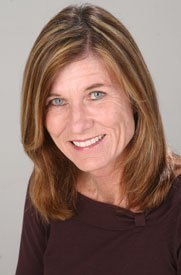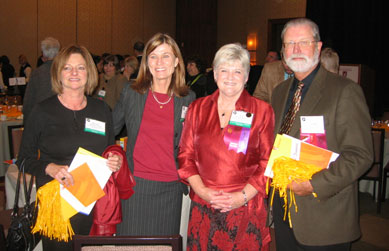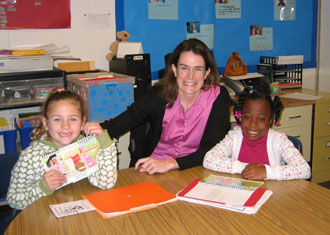Interview with Claudia Dunaway, CCC-SLP, Recipient of the 2007 Rollin J. Van Hattum Award
Linda Schreiber: I'm speaking this afternoon with Claudia Dunaway, who is a speech-language pathologist in San Diego, California. She is the recipient of the 2007 Rollin J. Van Hattum Award for Contributions in the Schools. She received her award at the recent ASHA convention in Boston. Hello Claudi
 Linda Schreiber: I'm speaking this afternoon with Claudia Dunaway, who is a speech-language pathologist in San Diego, California. She is the recipient of the 2007 Rollin J. Van Hattum Award for Contributions in the Schools. She received her award at the recent ASHA convention in Boston. Hello Claudia.
Linda Schreiber: I'm speaking this afternoon with Claudia Dunaway, who is a speech-language pathologist in San Diego, California. She is the recipient of the 2007 Rollin J. Van Hattum Award for Contributions in the Schools. She received her award at the recent ASHA convention in Boston. Hello Claudia. Claudia Dunaway: Hi Linda.
Linda: On behalf of the readers of Speech Pathology.com congratulations! Many of our readers are public school speech-language pathologists and they are in awe of what you've accomplished.
Claudia: What our team has accomplished, that's for sure!
Linda: How long have you been at the San Diego Unified School District and what can you tell us about your background experiences?
Claudia: I came to this district fresh from the masters program at San Diego State University and I've been here ever since. I've had lots of jobs within the school district, lots of different opportunities. I also worked at San Diego State University for almost 20 years as an instructor and as a supervisor in language, fluency, and counseling courses. That position was an important way to broaden my experiences. And I also worked in private practice for about 20 years.
Linda: You've had varied experiences.
Claudia: Yes, so I had a lot going on in different settings and it just all worked together to give me what I think is a good understanding of how kids think and talk.
Linda: I read that you have been honored for creating and sustaining 10 unique service delivery models or programs in San Diego. That is phenomenal. We want to know about them.
Claudia: Our goal has been to support our staff and to bring the most effective evidence-based methods to the district. And that's the purpose behind all of these programsto bring knowledge to our staff. We have a lot of resource programs going on. We have a very innovative Articulation Resource Center and a facilitator for that. The Resource Center is one of my prize accomplishments; but all I did was have the idea and then I was fortunate enough to be surrounded by a really competent team who knew how to bring those ideas to fruition.
Linda: Tell us more about the Articulation Resource Center. It sounds interesting.
Claudia: The Articulation Resource Center sponsors the speech improvement class, which is a response to intervention (RTI) approach to working with kids with articulation differences. We use the latest methodologies, we collect data, and we're able to provide short-term effective intervention. Most of our kids are in and out with corrected articulation errors within 20 hours.
Linda: I'm impressed.
Claudia: Yes, it's been really phenomenal in this district. We feel confident about the model. We've had about 200 inquiries from districts across the country and they're adopting and implementing the model too. We've significantly reduced the number of kids on IEPs and saved the district a lot of money and we've done it in a way that benefits students. That's always our first goalour first concernwhat can we do to serve our students.
Then we have an Apraxia Resource Center that is very similar. We have a facilitator who is very knowledgeable in specialized strategies in apraxia. We also have specially trained speech-language pathology assistants and we work with the kids who are identified as apraxic and need really intense service to make sure that they're getting the services that they need. These services are integrated through the school day as much as possible. We've had a lot of community support with this model and we've really reduced our complaints from parents and from advocates. They're now looking at us as a model instead of trying to fight us to get more services. We recognized the need and we were able to provide for it.
Linda: And these two resource centers are a part of your response to intervention (RTI) model?
Claudia: Our Apraxia Center is not so much response to intervention. It can be, but mostly these kids really do have a severe disorder that is affecting academic progress, so most of them immediately receive IEP services.
But certainly the Articulation Resource Center is our response to intervention model. It's our Tier Two response. It started as a Tier Two response but now that our staff is so excellent at providing interventions, we've been able to provide Tier One support to teachers so that they can work with the very mild kids, who are stimulable, within the classroom and feel confident in doing that.
Linda: Have the number of referrals decreased?
Claudia: The referrals have decreased but mostly the duration of therapy has decreased. Four years ago when we started, we did a survey about duration of services and discovered that most of the kids were on caseloads for 3 years. And they were getting 15 to 36 hours of services a year, so we knew that something was preventing correcting the articulation difference in a short period of time. We discovered that we could shorten that timewe were able to get it down to under 20 hours. I think 75 percent of the kids are done within 15 hours.
Linda: And you collected your own evidenceyour own datato show the child's needs could be met in that amount of time?
Claudia: We did, but I also convinced the district to hire a research evaluator. She helped us collect the datawe now have data for over four yearsso we're certain this is working.
Linda: How can others learn about this model?
Claudia: We wrote a manual that explains how you go about setting up the program and what the progress looks like. And that manual is available to anyone on the California Speech-Language-Hearing Association website www.csha.org/resource.htm
Linda: Thanks for sharing the manual. I am sure many readers will be interested in learning how to set up a similar resource center.
Linda: So you have shared two of the ten models; what else have you created?
Claudia: Well, the next one I will tell you about is one that I'm most proud of. It is what we call our Story Talk initiative. And this is an RTI intervention approach but can also easily be adapted as an intensive language intervention. It is a way of helping kids learn how to control their language so that it improves their oral narratives and their written language.
Linda: This sounds really interesting.
Claudia: It's really fun to do. We've had principals take this on and we've trained grade-level teachersespecially kindergarten to third grade teachersand they've reported dramatic, almost instantaneous, improvement in the kids' writing by using this approach.
Linda: Tell us more.
Claudia: It's a meaning-based approach. It is really just an experiential approach that includes evidence-based scaffolds we know really work. The approach teaches kids how to decide what matters and to talk about what matters in a way that is informative and interesting. They also learn how to use metacognitive strategies like rehearsal, scanning, and questioning, and how to organize and elaborate their language. We use a lot of modeling and coaching during our lessons. And then the classroom teachers and parents watch and soon they take it over and everybody's doing Story Talk. It's very fun and the kids are clearly motivated to participate, even those children for whom talking is a challenge. We have an article coming out soon in Seminars in Speech and Language describing this approach.
Linda: I look forward to reading about it. So does the content for Story Talk come from classroom content?
Claudia: No, it's from personal experience. Kids learn how to talk about their own lives in ways that are compelling. Because personal experience is so familiar to them, they've got the content. We can show them how to acquire all these metacognitive language strategies, while holding the content familiar and constant. So they're not working on content, they already have it. They're working on how they can talk about the content in a way that shows their thinking.
Linda: It sounds like so much fun for the kids. How do you as an SLP mesh with this model?
Claudia: I'm in the classroom two mornings a week doing demonstration classes. I'm in a special education classroom and in a general education classroom so anyone can come and watch me. And then quarterly, I hold formal classes where people come and watch. Once they've been through the class and make a commitment to try it at their site, they go back and partner with teachers and try it. I'll come to their site and work with them to strengthen their use of the techniques. Our staff just loves it.
Linda: So you have built training and staff development, and support and follow up into your schedule?
Claudia: Yes, it's all about support and professional development. While we might do some workshops that provide overviews, we really believe that our staff has to see it and try it with expert coaching to really make a change. And that's what our Articulation Resource facilitator does; that's what our Apraxia Resource facilitator does; that's what I do. And we have a group of senior SLPs who are trained in these methods as well as many others and that is what they do too. They're always out in the field working with staff; and they carry a caseload so staff can watch them at any time. And then we go out into the schools, upon invitation, and work collaboratively to improve their use of these different approaches. I think that's what's so innovative; that we implement best practices in ways that adults will want to learn. .
And implementing all of this in a school district can be challenging because of money, time, and other obstacles. We just ignored the obstacles and did it anyway.
Linda: So when you are looking for that best practice solution, are you doing a metanalysis of the literature and research that exists?
Claudia: Right. We read the research; we try different things; and we come together and talk about what works and what doesn't work. As a district staff, we usually agree on what we think the best practices are.
Linda: You have another model that is also evidence based and that's the SALT Lab.
Claudia: Oh yes, that was really fun to develop. We believe that language sampling is the very best way to set goals and document progress. However, we felt the data on which to compare performance had to come from our community. So we worked with Dr. Jon Miller at the University of Wisconsin in Madison to development a SALT database for San Diego. We worked with a couple other school districts in the area and we decided we wanted to have data related to conversation, narratives, and expository language. We worked together to set the protocols and then went out and collected over 250 samples. Jon was great. He completed the SALT analysis on these for us. So we had both a quantitative and qualitative analysis for these areas. Now we have a database that people can use that we feel really reflects our population.

Linda: That's about as ideal as it gets really.
Claudia: We have so many smart people here who are really interested in research and evidence-based practice. Our district is so innovative. I received the award but it's my colleagues in San Diego Unified that really deserve the honor and recognition.
Linda: We all know that with the support of a district, you can accomplish so much for students.
Claudia: I think for excellence you have to have teamwork.
Linda: Any other models you want to share?
Claudia: We have a preschool initiative with all the preschools in the county. We're forming a coalition and using the expertise of the speech-language pathologist to work collaboratively with preschool teachers to build their competency in developing language in the classroom. This is another response to intervention approach.
We looked at some of the research out of the University of Cincinnati. They've done a lot of work with Head Start. They identified language strategies that were particularly powerful in facilitating language growth and we're developing training programs to teach those strategies to preschool teachers. Our SLPs will be working with the preschool teachers, so if they get a referral, the first step would be to go in and work with the instructional language in the classrooms in authentic contexts.
Linda: You have a lot going on.
Claudia: And we have a high school initiative where were working to integrate skills into the classroom instead of doing pull out. We've used some of the work that the Minneapolis school district has developed. And by the way, we're interested in what other school districts are doing because we don't want to reinvent things.
The Minneapolis school district has done some great curriculum development in speech and language for kids with moderate-to-severe impairments. We are trying to adopt that model because we think it is very effective for the speech-language pathologist to work collaborativelyto coteachin a classroom with either the special educator or the general educator.

Linda: I have seen that work successfullyit's a good model. Any other models you have found work effectively in San Diego?
Claudia: Well we brought the SCERTS model to San Diego. SCERTS is a curriculum for developing communication and emotional regulation for student on the autism spectrum. It's the curriculum that Barry Prizant, Amy Wetherby, Emily Rubin, and Amy Laurent put together. We're so lucky that Emily Rubin (of Communication Crossroads) has been our consultant for this program. We have a number of schools that we call SCERTS schools where all the staff is working from a SCERTS perspective to provide support for students with autism at their site.
Claudia: The other thing we're focusing on is performance-based assessment. Dr. Jack Damico, from the University of Louisiana at Lafayette, is our consultant. We wrote a manual that we're sharing with people about transdisciplinary assessment that explains what performance-based assessment looks like and how teams go about implementing it. So we have a manual for the Articulation Resource Center and a manual for our transdisciplinary performance-based assessment.
Linda: And you are willing to share these with others?
Claudia: We are willing to share with people, yes. The Single Sound Articulation Differences and Disorders Manual is on the CSHA website. Your audience can write to me for a copy of the Performance-Based Assessment Manual too: [email protected]
Linda: Claudia, I appreciate your taking the time out of your obviously busy life to share these great ideas with us. I know our readers will be in touch with you. Best wishes to you in San Diego.
